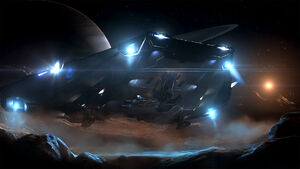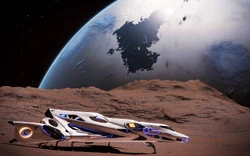
A Cobra MkIII preparing to land on a planet's surface
Planetary Landings are the act of landing on the surface of a terrestrial body with a ship. This requires installing either a Planetary Approach Suite, which allows landings on planets with no atmospheres, or an Advanced Planetary Approach Suite, which allows landings on planets with no atmospheres or tenuous atmospheres. Landing on planets with atmospheres greater than 0.1 atm is not currently possible.
Overview[]
Players are able to land on four types of airless planets - rocky, metal, ice and rocky/metal - which make up 61% of the planet types in the Milky Way galaxy. These planets vary in size and composition, therefore having different gravity forces affecting the flight and landing dynamics.
Some celestial body types, including water worlds and bodies with significant amount of lava covering their surface, cannot be landed on even when they have no atmosphere. The reason for this is likely due to there being no current game mechanic to deal with water, lava, and other large bodies of liquid substances. Earth's moon, Luna, cannot be landed on despite a lack of atmosphere; it is not known why. All yellow-coloured volcanic moons (similar to and including Jupiter's moon Io) will list 0.00 atmospheres, and cannot be landed on. The reason for this is unknown, though it could be due to the large amounts of volcanic activity on these moons, requiring implementation of their own game mechanics. Some bodies are permit locked for unknown reasons and therefore cannot be landed on. An example of this is Neptune's moon Triton, which could be landed on until it was unexpectedly permit locked.

Diamondback Explorer approaches a Settlement on a planet
The landings are graphically seamless with a small pause for instance loading, including peer-to-peer (p2P matchmaking and instance creation, and the planets can be explored in low-level flight or by using a Surface Reconnaissance Vehicle.[1] Once on the surface, players can discover natural and artificial Points of Interest, including Settlements, Surface Ports, Shipwrecks, and more. The nature of the encounter may vary depending on the planet type and composition, and the local topography affected by geology.[2]
Landing[]

Imperial Clipper landed on an airless world
Landing on a planetary surface requires installing the Planetary Approach Suite or Advanced Planetary Approach Suite, without which a ship will not be able to descend from orbit. The process of landing also involves more ship management than dropping from supercruise at an orbital Station or another point of interest. It is recommended to check the gravity of the targeted planet or moon in the System Map before attempting a landing, as high-gravity worlds can overwhelm ships with weak thrusters and cause them to crash or touch down too quickly and inflict severe or fatal damage.
- Select a landable planet or moon, and any desired PoI on its surface, and approach it in supercruise.
- Keep ship speed in the blue zone when near enough to the planet/moon that it becomes visible to the eye. If the gravity is lower than 0.5 G, speed may need to be further decreased, possibly to the minimum, to ensure a smooth passage through the planet/moon's exclusion zone and prevent an emergency drop.
- Orient the ship so that it is approaching the desired landing site on the surface at an approximate 45 degree angle for the descent. A shallower angle will increase the time that the ship takes to descend and possibly result in overshooting the destination, while a sharper angle risks a collision with the surface or dropping out of supercruise hundreds of kilometers away from the destination, but the angle does not need to be exact.
- Passing through the blue line surrounding a landable planet/moon will cause the ship to enter Orbital Cruise and the HUD to generate the altitude and G meters. Check the ship's descent angle relative to the destination and keep it out of the red zone without shallowing out. If speed is not already at minimum and the ship is decreasing altitude too fast to adjust its course, which is common with small, low-G worlds, decrease speed now.
- At 25 km above the surface, the ship will drop from supercruise and enter a glide for the final stage of the landing process. If the ship's speed is too high when it reaches the 25 km zone, an emergency drop will occur instead, and if the angle of descent is too shallow during the glide, the glide will fail and the ship will return to supercruise. The ship will maintain a speed of 2.5 km per second during the glide.
- As the glide continues, take one last opportunity to check and adjust the angle of descent. If the ship is descending too quickly, shallow out the glide to prolong it, and if the ship is overshooting the destination, angle it downward to end the glide faster.
- At 3 km above the surface, the ship will emerge from the glide and revert to normal space thrusters. If the landing process up to this point was performed correctly, the ship should be a handful of kilometers away from the destination or even directly above it.
- To land at a Surface Port, request docking permission as with an orbital station, then dock as usual. To land directly on the surface of a planet/moon, decrease altitude and extend landing gear when the HUD radar begins displaying the terrain. Look for a relatively smooth, flat area large enough for the ship. The HUD will indicate when the ship is above a suitable landing zone and is level with the surface. Upon a successful landing, the ship's thrusters will automatically deactivate.
Largest landable planets[]
These are the 10 largest known landable planets.[3]
| Rank | Radius (km) | System | Body | Type | Discovered by |
|---|---|---|---|---|---|
| 1 | 28,878 | Greae Hypa PH-C d1017 | 2 | Icy body | |
| 2 | 28,514 | Hyuqau RI-Z d1-7809 | 1 | Icy body | |
| 3 | 28,205 | Wepae NY-R d4-3425 | 2 | Icy body | |
| 4 | 27,967 | NGC 6705 Sector WO-Q c5-0 | AB 4 | Icy body | |
| 5 | 27,954 | Aiphaitl VE-P d6-25 | 1 | Icy body | |
| 6 | 27,850 | Kyloall YD-S d4-5226 | 1 | Icy body | |
| 7 | 27,796 | Blaa Phrae SZ-F d11-7 | 1 | Icy body | |
| 8 | 27,486 | Clooku SJ-X d2-174 | DE 9 | Icy body | |
| 9 | 27,395 | Drojau QY-R d4-5 | 1 | Icy body | |
| 10 | 27,031 | Jewel Box Sector RI-T d3-48 | 1 | Icy body |
Smallest landable planets[]
These are the 10 smallest known landable planets.
| Rank | Radius (km) | System | Body | Type | Discovered by |
|---|---|---|---|---|---|
| 1 (tied) | 137 | Flyiedgiae QN-T d3-17 | AB 1 b | Metal-rich Body | CMDR Evyl Minkey |
| 1 (tied) | 137 | Pria Thoi ZP-G d10-37 | AB 4 a | Metal-rich Body | CMDR Ulvkar |
| 3 | 139 | Pyroifoi SO-Z e9 | A 3 a | Metal-rich Body | CMDR Hayden Eliback |
| 4 | 142 | Dryoea Blao YA-O e6-7737 | 2 d | Metal-rich Body | CMDR Unifex |
| 5 | 157 | Scrauja TO-R D4-0 | B 4 a | Metal-rich Body | CMDR Hyperion Tyler |
| 6 | 160 | Sol | Hi'iaka | Icy Body | Michael E. Brown Chad Trujillo David Rabinowitz |
| 7 | 161 | Ancha | A 1 a | Metal-rich Body | |
| 8 | 167 | Dahan | Coltan | Metal-rich Body | |
| 9 | 182 | Hypao Brai KW-V b5-2 | 1 a | Rocky Body | CMDR Valemax2 |
| 10 | 184 | Pyroifoi SO-Z e9 | A 3 b | Metal-rich Body | CMDR Hayden Eliback |
Notes[]
- Planetary Landings were added with the Elite Dangerous: Horizons 2.0 update on December 15, 2015.
- Planetary landings on planets with tenuous atmospheres will be introduced with Elite Dangerous: Odyssey on May 19, 2021. This will expand the number of landable bodies in Elite Dangerous by approximately 20%.[4]
Videos[]
See also[]
- Atmospheric Landings
- Development Plans
- Elite Dangerous: Horizons
- Planetary Vehicle Hangar
- Points of Interest
- Procedural Cities
- Scarab
- Settlements
- Surface Ports
- Surface Recon Vehicles
References[]
- ↑ Kickstarter: Elite: Dangerous
- ↑ Elite Dangerous Newsletter #97
- ↑ Spansh Plotter: Body Search Results (Data gathered on January 31, 2022)
- ↑ Frontier Forums: Elite Dangerous: Odyssey Q&A- First Footfall




